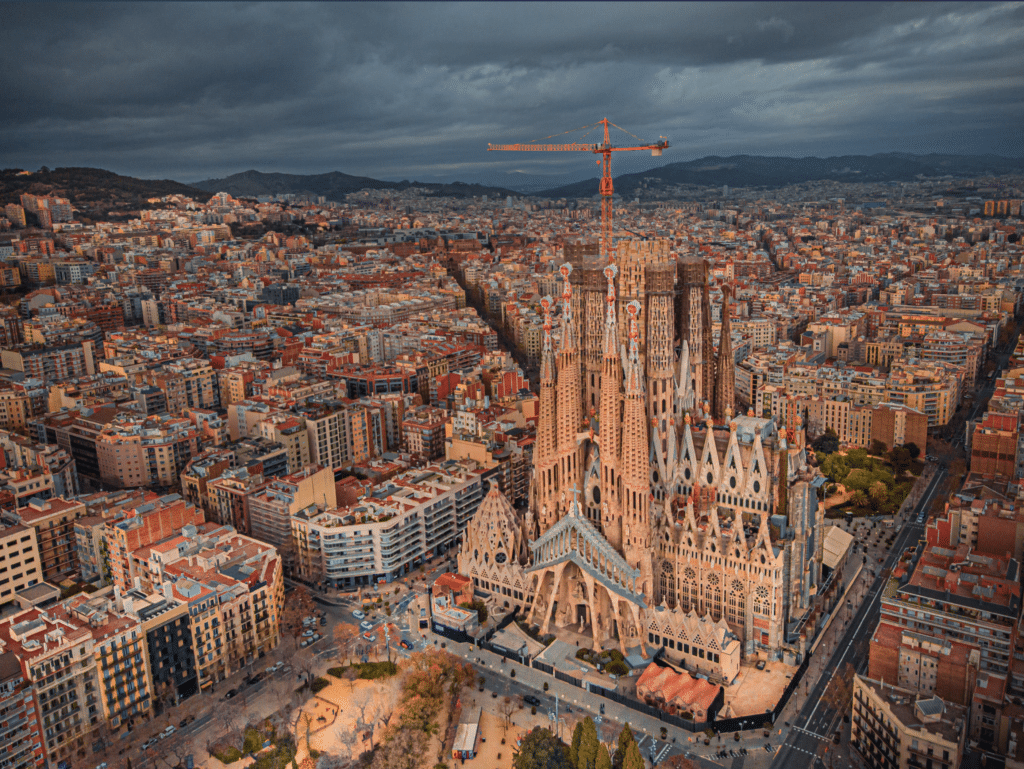Barcelona, a vibrant city nestled between the Mediterranean Sea and the Collserola mountain range, offers an enchanting blend of history, art, and cuisine. Known for its architectural marvels, bustling markets, and lively streets, this Catalan capital invites travelers to immerse themselves in its unique culture. Here’s your guide to the top things to see, do, and eat in a day in Barcelona, Spain, ensuring you capture the essence of this dynamic city.
About Antoni Gaudi
Antoni Gaudí i Cornet (1852–1926) was a Catalan architect known for his unique style and significant contributions to the architectural movement known as Catalan Modernism. Gaudí’s works are marked by their individuality, texture, and vibrant colors, combining Gothic and Moorish influences with his innovative use of shapes found in nature.
Gaudí’s work was greatly influenced by his passions in life: architecture, nature, and religion. He considered every detail of his creations and integrated into his architecture crafts such as ceramics, stained glass, wrought ironwork forging, and carpentry. Gaudí also introduced new techniques in the treatment of materials, which became hallmark traits of his work.
His most famous work, the Sagrada Família, is a colossal church that remains under construction in Barcelona. Begun in 1882, Gaudí became involved in 1883, transforming the project with his architectural and engineering style—combining Gothic and curvilinear Art Nouveau forms. Gaudí devoted the latter years of his life entirely to this project.
Other notable works include Park Güell, Casa Batlló, and Casa Milà (La Pedrera), each showcasing Gaudí’s innovative use of shapes, light, and space. His buildings are characterized by vibrant colors, textured surfaces, and organic-looking forms, often inspired by natural elements.
Tragically, Gaudí’s life ended abruptly when he was struck by a tram on June 7, 1926, in Barcelona. Due to his modest attire and lack of identification, he was not recognized and received only basic care. He died three days later, on June 10, and was buried in the crypt of the Sagrada Família, surrounded by his most iconic work.
Despite his death, Gaudí’s legacy endures, and his work continues to influence architects and artists worldwide. In 1984, several of his works were declared UNESCO World Heritage Sites, cementing his status as a pioneer of modern architecture and one of the most extraordinary architects of his time. Gaudí’s imaginative buildings are seen not just as structures but as artistic masterpieces that blend architecture with sculpture and painting.
Things to See in Barcelona
1. Sagrada Familia
No visit to Barcelona is complete without marveling at the Sagrada Familia, Antoni Gaudí’s unfinished masterpiece. This basilica, a UNESCO World Heritage Site, is a testament to Gaudí’s innovative vision, with its intricate facades and soaring towers that blend Gothic and Art Nouveau styles.
The Sagrada Familia, a monumental church in Barcelona, Spain, is one of the most iconic and visited monuments in the world. It stands as a testament to the genius of its architect, Antoni Gaudí, and his unique approach to Catalan Modernism. The history of the Sagrada Familia is a fascinating journey that spans over more than a century, reflecting not only architectural evolution but also the social, political, and cultural shifts of Barcelona and Spain.
Foundation and Gaudí’s Involvement
The project was initiated in 1882 under the direction of architect Francisco de Paula del Villar, who originally designed a traditional Gothic revival church. However, due to disagreements, del Villar resigned a year later, and the task was handed over to Antoni Gaudí in 1883. Gaudí radically transformed the design, incorporating his distinctive style characterized by curved lines, intricate details, and textures inspired by nature.
Gaudí devoted the last years of his life entirely to the Sagrada Familia, living as a recluse on the site. His vision was so ambitious that he knew the church would not be completed in his lifetime. He died in 1926 after being struck by a tram, with less than a quarter of the project completed.
Progress and Delays
After Gaudí’s death, the construction of the Sagrada Familia continued under various architects who tried to remain faithful to Gaudí’s original designs and intentions. However, progress was slow due to a lack of funding and the outbreak of the Spanish Civil War in 1936. During the war, parts of Gaudí’s models and workshop were destroyed, complicating the continuation of his vision.
Modern Times and Completion Efforts
Since the late 20th century, the project has seen accelerated progress thanks to modern construction techniques and increased funding, much of it coming from the millions of tourists who visit the church each year. New technologies, such as computer-aided design and 3D printing, have been instrumental in interpreting Gaudí’s complex designs and continuing the construction in line with his vision.
The church was consecrated by Pope Benedict XVI in 2010, elevating it to a basilica. As of my last update in April 2023, the Sagrada Familia is still under construction, with completion aimed for 2026 to coincide with the centenary of Gaudí’s death. This timeline, however, is subject to change.
Architectural Significance
The Sagrada Familia is celebrated for its astounding architectural and engineering features, including its towering spires, elaborate facades, and the extensive use of naturalistic motifs. Each element of the church is rich with Christian symbolism, from its structure mimicking a forest canopy to its facades depicting scenes from the Bible.
Legacy
The ongoing construction of the Sagrada Familia over more than a century reflects a unique blend of historical craftsmanship and modern innovation. It remains a symbol of faith, art, and the enduring legacy of Antoni Gaudí, whose visionary approach to architecture continues to inspire and awe visitors from around the world. The completion of the Sagrada Familia will mark not just the end of an architectural project but the realization of a masterpiece that bridges past, present, and future.
2. Park Güell
Another of Gaudí’s creations, Park Güell, is a public park filled with colorful mosaics, whimsical structures, and breathtaking views of the city. It’s a perfect spot for a leisurely stroll or a picnic, offering a glimpse into Gaudí’s imaginative mind.
Park Güell is one of Barcelona’s most enchanting landmarks, a public park filled with gardens, architectural elements, and stunning mosaic work, all designed by the renowned Catalan architect Antoni Gaudí. Commissioned by Eusebi Güell, a wealthy entrepreneur and Gaudí’s patron, the park was originally intended to be a residential garden city with luxury homes. However, the project was commercially unsuccessful, and only two houses were built, neither designed by Gaudí himself. Despite this, the project evolved into one of Gaudí’s most colorful and imaginative works, blending his deep passion for natural forms and innovative architectural techniques.
History and Development of Park Guell
Construction of Park Güell began in 1900 and continued until 1914, with Gaudí living in one of the houses in the park from 1906 until his death in 1926. The park was named after Eusebi Güell and was conceived as a symbiosis between architecture and landscaping, with paths, viaducts, and steps integrated with the natural contours of the land. When the project was abandoned as a commercial venture, it was eventually bought by the city and opened as a public park in 1926.
Architectural Features
Park Güell is renowned for its main terrace, surrounded by a long bench in the form of a sea serpent covered in trencadís (a type of mosaic made from broken tile shards). The park is also famous for the Hansel and Gretel gatehouses, the dragon fountain at the main entrance, and the winding, columned pathways that mimic the trees above them. Gaudí’s work on the park showcases his innovative use of structural solutions and his artistic flair, with the park embodying his belief that nature and architecture should exist in harmony.
UNESCO World Heritage Site
In 1984, Park Güell was declared a UNESCO World Heritage Site under “Works of Antoni Gaudí,” recognizing its unique contribution to the development of architecture and building technology in the late 19th and early 20th centuries. The designation celebrates the park’s exceptional creative contribution to the architectural heritage of humanity.
Cultural and Social Significance
Today, Park Güell is a symbol of Barcelona’s cultural heritage, attracting millions of visitors each year who come to admire its artistic and architectural wonders. It stands as a testament to Gaudí’s genius and his ability to harmonize the natural landscape with his architectural designs. The park not only offers breathtaking views of Barcelona but also serves as a public space where art, nature, and architecture merge to create a magical experience.
Park Güell remains a lasting legacy of Gaudí’s visionary approach to architecture and his deep reverence for the natural world, making it a must-visit for anyone exploring the beauty and history of Barcelona.
3. Gothic Quarter
The Gothic Quarter, with its narrow medieval streets, hidden squares, and ancient buildings, feels like stepping back in time. Highlights include the Barcelona Cathedral and the Plaça del Rei, a historic square that hosted many significant events in Barcelona’s history.
Things to Do in Barcelona
1. Stroll Along La Rambla
La Rambla is a bustling boulevard that runs through the heart of the city, lined with street performers, local vendors, and outdoor cafes. It’s the perfect place to soak up the lively atmosphere and observe the daily life of Barcelonians. Grab some Iberico Ham and fresh baked bread along your stroll!
2. Visit La Boqueria Market
La Boqueria is Barcelona’s most famous market, offering an explosion of colors, aromas, and flavors. Here, you can sample local delicacies, buy fresh produce, or simply wander through the aisles to experience the vibrant food culture.
3. Explore Montjuïc
Montjuïc is a broad hill overlooking the harbor, home to several attractions including the Montjuïc Castle, the Magic Fountain, and the Joan Miró Foundation. It’s a great area for hiking, enjoying panoramic views, and exploring Barcelona’s cultural offerings.
Things to Eat in Barcelona
1. Tapas
No trip to Barcelona is complete without indulging in tapas, small dishes shared among friends. Popular options include patatas bravas (spicy potatoes), bombas (meat-stuffed potatoes), and pan con tomate (bread with tomato).
2. Paella
While paella originates from Valencia, Barcelona offers its own delicious versions of this iconic Spanish dish. Seafood paella, with its rich flavors and fresh ingredients, is a must-try along the city’s beachfront restaurants.
3. Crema Catalana
For dessert, savor the Crema Catalana, a rich custard topped with a layer of hard caramel. This local version of crème brûlée is a delightful way to end any meal.
Conclusion on a Day in Barcelona
Barcelona is a city that captivates the senses, from the awe-inspiring creations of Antoni Gaudí to the lively streets of the Gothic Quarter and the tantalizing flavors of its cuisine. Whether you’re exploring its historic sites, enjoying the vibrant street life, or indulging in the local gastronomy, Barcelona promises an unforgettable experience. With so much to see, do, and eat, Barcelona beckons travelers to discover its charms and embrace the spirit of Catalonia.

